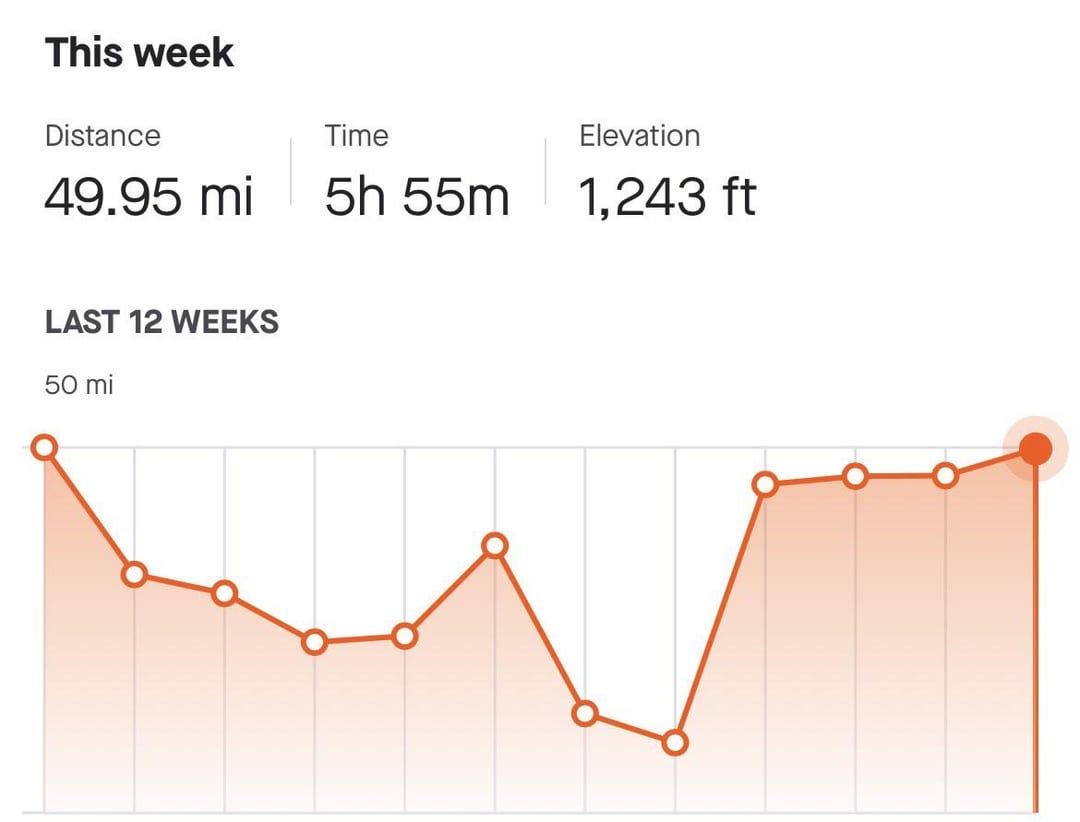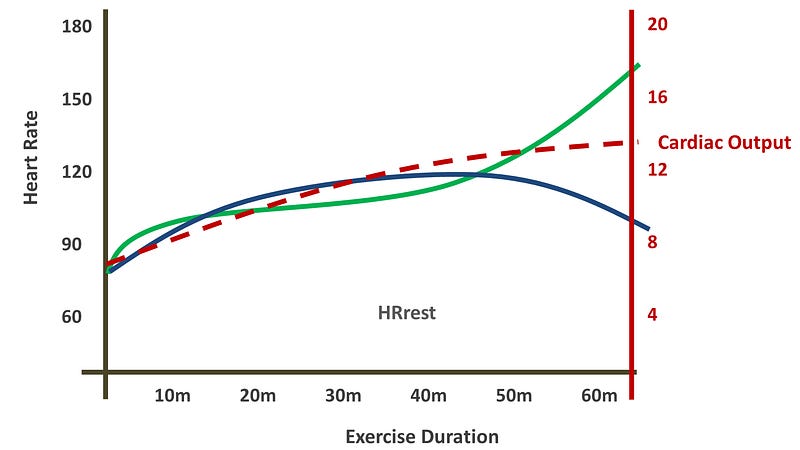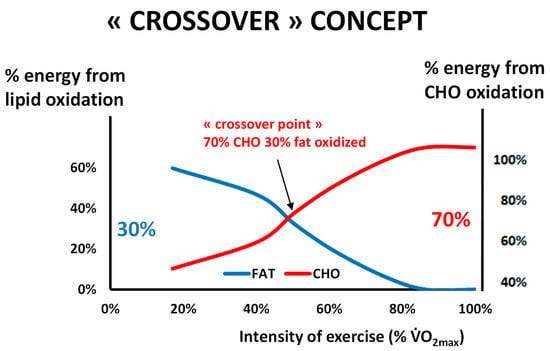2025: Increase Your VO2 Max
What 5 Hours A Week of Cardio Looks Like
5 hours a week of cardio is the perfect volume load for the amateur athlete, someone wanting to increase their VO2 Max, or gain general fitness. Whatever the goal, being able to maintain 5 hours of cardio per week is the north star to shoot for if you live a normal life with responsibilities (work, family, kids, etc.)
An allotment of 5 hours should not need *too much* reallocation from other areas of your life, which is the best feature about this approach. It does take medium chunks of time (~60 minutes + recovery), making it not as appealing compared to 30 minute workouts. But here we go against the grain, playing the long game rather than advocate for get-fit-quick schemes.
This method requires you to give up the notion of a short workout. It helps you understand there are no shortcuts when it comes to cardiovascular health. If you run 30 minutes when you were supposed to run 60 minutes, that time, on a weekly basis, must be made up elsewhere. It becomes increasingly easy to fall behind on time this way (as life issues pop up). The real goal is to get your life in a place where there is minimal outside stress, and the only real stress entering your life is training stimulus!
But that’s a conversation one needs to have with a life coach. I am a mere running coach.
Now let’s make 2025 the year you increase your body’s ability to intake oxygen and deliver said oxygen to your muscles under stress! (VO2 Max)
People confuse new runners with what heart rate zones they must be in, when to apply intensity, how many miles to run, or when to add different stimulus.
The bottom line is if you are *not* doing 5 hours of cardio per week yet, then the first goal is to reach this volume baseline consisting of almost all easy work. I say “almost” because things like strides or the odd workout are still helpful, but in the short term they can become a hindrance if overdone.
Training load as it pertains to volume must be adapted to first. Once you get used to 5 hours per week of all easy work, you can slowly start to recruit new adaptations with higher intensity as the weeks/months go on. Soon weeks turn to 4.5 of easy work + 30 minutes of higher intensity. The wider your aerobic base, the more room to absorb higher intensity training.
Regardless of how you will split up your training week, every Monday to Sunday should consist of 300 (5 hours) total of cardiovascular output. For the context of this article, I am defining cardiovascular output as above ~115 BPM and *not* walking.
The Power of a 5 Day Week
Having five days of cardio per week is extremely powerful for two reasons:
Increases the average run length/time to hit volume goals.
Allows 2 hard rest days for recovery
(Note: Most people can actually get 5 hours done in 4 days, and actually should for efficiency reasons, but if you want to eventually go higher than 5 hours then upping your frequency to 5 is better in the long run.)
Most humans who are non-elite athletes (99.99% of us), really can’t handle more than 5 (6-7) days of cardio per week. The strain on your aerobic system becomes massive. Chronic fatigue arises, immune system takes a hit, along with an imbalance of your hormonal and endocrine systems. It becomes really easy to put yourself behind the 8-ball.
The best part is, once you grow your heart and become an efficient runner, you can actually dial back down to 4 days of cardio per week, and still maintain 5 hours of cardio. Of course, this is only if you want. Most people decide to continue chasing new heights—while others have business, life, family obligations that hold them back for the time. Which is fine and health optimization during a busy life is a perfect goal, aside with performance.
Step 1: Track Everything
Strava gets a lot of heat, but for a free app that plugs in quite easily with Garmin/Coros/Apple, it provides you the most useful charts for tracking your volume. As an mental exercise, this is beneficial psychologically for you to see explicitly laid out how much work you have done in the past.
Every walk (above 100BPM), cycle/bike ride, swim, run, hike, stairmaster, or any other cardiovascular modality…LOG IT.
There will be times when you think you are not doing enough pure running, but when you look back you will be thankful for banking all forms of cardio. It is also a good gauge of “total movement”, especially when tracking walks, this helps you plan your days out and understand how much movement is really needed to stay fit. Think run in the AM, walk in the afternoon and one in the evening. That’s 2 hours of movement, with both walks probably above 100BPM; perfect for active recovery, adding to fat adaptation from glycogen depletion due to morning run, and simple zone 0 stroke volume. Bottom line is to get your heart beating!
Step 2: Understanding Stress
As I just mentioned above, you should 1) log everything and 2) Get your heart beating more often. The problems that arise for many people is when your body is under stress (outside of training) and you do not know it. Newer wearables such as Whoop and Oura are getting better at pointing this out to users, but work, life, relationship, family, and business stress all add to your overall load (inclusive of training). This is where things tend to go south in training, both mentally and physically.
(The goal is for your stress to be low outside of the time you are exercising.)
At least understanding when life stressors are placed on you, if you don’t want to track with a wearable, is necessary. This takes a bit of self-awareness to actually implement. As an example, many people have a crappy day at work and then feel the need to workout as hard as possible to “relieve stress”. This may work in some training scenarios *outside* of running/endurance, but the opposite must be applied. If some factor outside of training stresses you out (increases blood pressure and resting heart rate, declines your HRV), then an easier workout should be on deck. You will now need to recover from the life stress and training stress. The goal is to at least keep one of them low.
This is one factor as to why elite athletes are able to train so much. They have little outside-of-training stress. It’s also an important marker for longevity and overall health. Remove unneeded stress on your life and you will see all facets of your life grow, inclusive of your specific training and performance goals.
Step 3: Crosstrain at Will
This is important (and tied to steps 1 & 2) for essentially everyone, regardless if your goals are performance based or health based.
For every amateur endurance athlete, performance and health are linked to one thing: Quality Hours Under Stress. You can track per week or per year, it doesn’t really matter (best to do both, but start with at least 5 hours per week to stay consistent).
When I say quality hours, I mean do whatever in the moment is the best “bang for your buck” on efficiency and will not set you back.
Weird soreness in the back of your knee from running two days in a row? Hop on the bike in zone 2 today instead of running again. Same goes elliptical, going for a hike, Stairmaster, swimming, etc. The goal is to not be hurt, so you can be consistent.
Obviously the best way to do go about structuring your week is to build in cross training so you rarely need to apply it as a band aid.
Template for a 4-5 day schedule:
Monday: High Intensity Run
Tuesday: Cross train
Thursday: Run
Friday: Run
Saturday: Run/Cross train
Sunday: Rest
If running 4 days a week, keep the last day of the week a “flex” day, to change as needed. and take a rest day on Thursday.
When cross training, use the fact that the impact on your muscles is much lower than when you’re running, so you can ramp up the intensity slightly. Any cross training modality will *feel* harder to get your HR up into zone 2-3. Whereas running it feels natural and smooth, on a bike it is very hard. This sets you up nicely for outputting power though, since in order to increase your HR on any cross training machine, you will need to up your power output significantly.
For example 150BPM while running may feel normal, and a classic zone 2-3 effort, but on the bike that will take a lot of power output to match and your quads will be worked more than usual (this is a good thing).
Also play around with different cross training, a popular version is jogging at an incline on a treadmill. It’s similar premise to riding a bike, you are lower the impact while maintaining a normal heart rate.
Step 4: Hydration and Fueling
Most new runners have an extremely low amount of blood volume (this will increase with time).
Blood volume in the context of running refers to the total amount of blood circulating in a runner's cardiovascular system. This is an important factor for us because blood volume directly impacts the body's ability to deliver oxygen and nutrients to working muscles.
As you run more, your body will adapt and blood volume will increase, as you produce more red blood cells and plasma.
Why this matters? As you become dehydrated, the plasma in your blood also decreases, which increases your heart rate.
Cardiac Output = Heart Rate * Stroke Volume
Where the blue line is SV, green line is HR, and dotted red is CO.
As you run, you begin to get dehydrated. As you get dehydrated, there is less plasma in your blood, and this decreases the amount of blood available to return to the heart (flow). To counteract this, your heart rate increases to maintain the same effort (cardiac output), see above formula.
To front run your bodies response of increasing your HR due to dehydrated and lower plasma in your blood, you can carry water with you while running.
This can be small 8oz, or you can wear some piece of kit (belt/vest/handheld) to carry more. Whatever it is, don’t feel ashamed you need to bring it, water is life! Keep that HR down.
A normal fit/athletic male can sweat 800ml-1L on a hot day, this can wreak havoc on even the fittest of us. Bring enough water to mitigate the damage at times. This can mean a running belt where you stuff a 500ml soft flask inside of if you have to.
Intra run fueling will be different from runner to runner.
Calorically:
Some runners may be *very good* at burning fat and not need a single calorie when running 90+ minutes (do not try this). These are usually advanced marathon runners or experienced ultra runners.
New runners will may not be able to run at an effort inside of the zone where you are burning majority of fat for fuel. This will mean for any run over 60 minutes, an intra-run fuel could be a good idea, and any run that will be 90 minutes or over—calories mid run are needed.
The general rule of thumb is to consume one serving of carbs every ~40 minutes. One “gel” is usually 90-100 calories and 23-24g of carbs.
Another good way of looking at it is if you’re new and running 60 minutes, take one at the half way point (or don’t at all). If running 90 minutes, take one at the half way point (45 minutes).
If running over 2 hours, take one every ~40 minutes for the duration of your run.
Step 5: Stay Consistent and Set Up Races
Signing up for races makes you stay consistent, it’s a solid external motivator but at the same time you have to enjoy it. Enjoying it comes to making your training repeatable (easy), time efficient, and injury proof while making your goals attainable.
A few common goals for new road runners are things like:
25 minute 5K
4 Hour Marathon
2 hour Half Marathon
(See all of my training plans here, inclusive of the above and many others — LINK)
Staying consistent also means that volume is not always the answer. Yes, it is the answer if you are below 5 hours, but for most, much more than that is not necessary. Progressive overload does not work in endurance as it does in lifting (strength training / hypertrophy). If you come from this background, not improving week to week may sound insane to you. Doing the same thing day in and day out without "gains” being seen can infuriated.
Endurance needs to be looked at on a long time frame, years even. The lowest hanging fruit is to look at your paces at “easy”, “tempo”, and “threshold” every 2-3 months (with consistent training in-between) to get a solid picture of how you are progressing early on. Of course, the biggest returns are in the beginning, so expect these to slow down, but the gains should still be there. Celebrate running 3-5 seconds per mile faster than you were 2 weeks ago. Where before 30 seconds difference seemed small and just “depended on the day” these single digit seconds will sound astronomical shortly.
Breakthroughs come from combining consistent training (+ pull back weeks) with breakthroughs via racing.
Set yourself up so you’re always logging a few hours every week, and focus your training (burst/peak) around races. The above shows an athlete of mine working in bursts around races, but generally staying in motion throughout the year to not lose fitness.
-BTR
A lot more to come in 2025!
FYI I offer 1:1 coaching that is $150 per month. Schedules are sent out on a weekly basis with the training week being Monday-Sunday. We will be in constant communication and tailoring your training to your schedule as needed. It is not a “plug and play” but highly custom and ever-changing.
Feel free to email me for more detail at bowtiedrunner@gmail.com







